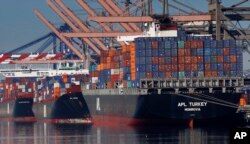U.S. President Donald Trump is again criticizing China on trade.
Trump wrote on Sunday, “The Trade Deal with China continues, but too slowly, as they attempt to renegotiate. No!”
His comments appeared on the news and social media service Twitter. The president followed that Monday with more tweets about trade imbalances.
He wrote, “The United States has been losing, for many years, 600 to 800 Billion Dollars a year on Trade. With China we lose 500 Billion Dollars. Sorry, we’re not going to be doing that anymore!"
Trump announced that he would raise taxes on $200 billion dollars of imports from China. His warning marked an escalation in the trade dispute between the world’s top two economies. His comments come after months of apparent progress in negotiations.
The announcement caused prices on international financial markets to drop. It also led some observers to suggest that China might pull out of negotiations set for this week.
Trade war
The trade war officially began in July of 2018 when the Trump administration ordered taxes on $34 billion of Chinese imports. That was followed by new tariffs on an extra $16 billion in August and another $200 billion in September.
China has answered each of these moves with its own set of tariffs.
Two months ago, the Trump administration threatened to raise more tariffs on the September list of products. But that move was suspended, pending trade talks.
In the latest development, Trump on Sunday said those increases could now take effect this Friday. He also announced that he would target a further $325 billion of Chinese goods “shortly.”
If they take effect, the tariffs would effectively cover all imports of Chinese goods into the United States.
Here is a look at the effect the trade war has had on the two countries and the rest of the world.
U.S.-China trade
In the first three months of 2019, Chinese imports fell almost a third compared to a year earlier. Exports fell almost a tenth during the period. In dollar terms, a loss of $25 billion in two-way trade represents around 0.5 percent of the world’s trade.
The majority of the decline in U.S. exports to China is in raw or unprocessed materials and food. They represent about a third of the total and have more than halved. That information comes from Oxford Economics, which advises more than 1,500 businesses worldwide.
Of all Chinese exports to the United States, machinery and electrical equipment have taken the biggest hit.
Economic growth
China’s economy grew at a yearly rate of 6.4 percent in the first three months of this year. April to June of 2018 was the last quarter before the U.S. tariffs took effect. During that period, the Chinese economy grew at a yearly rate of 6.7 percent.
The U.S. economy grew 3.2 percent in the first quarter of 2019, faster than the 2.9 percent in the last quarter before the trade war.
Most economic observers say the losses for both countries could increase with more, and higher tariffs.
Effect on other trading partners
A study by the Center for Economic Policy Research showed that about $165 billion in trade has been lost or redirected in order to avoid tariffs.
In the first three months of 2019, U.S. imports of furniture from China fell 13.5 percent. That compares with a 37 percent increase in imports from Vietnam and a 19 percent increase from Taiwan.
For refrigeration equipment, U.S. imports from China fell 24 percent, but South Korea and Mexico each experienced 32 percent jumps. Tire imports from China fell almost 29 percent, while those from Vietnam rose over 140 percent.
After Trump's tweets, measures of major stock markets around the world all fell on Monday.
The famous American investor Warren Buffett added, “If we actually have a trade war it will be bad for the whole world.”
I’m Jonathan Evans.
George Grow adapted this story for Learning English based on Reuters and Associated Press news reports. Hai Do was the editor.
_______________________________________________________________
Words in This Story
escalation – n. the act of increasing in number, amount of intensity
pending – prep. while awaiting; during
furniture – n. chairs, tables and/or other equipment for the home or office
tire – n. a piece of rubber than covers a wheel of an automobile or other vehicle
We want to hear from you. Write to us in the Comments section, and visit our Facebook page.














